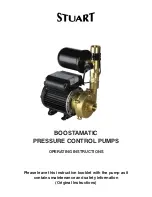
Monobloc Outdoor Unit Service Manual
148
•
Charge
DO NOT OVERCHARGE the system. Overcharging results in higher discharge pressure, which could lead to possible
compressor damage and also higher power consumption.
Refer to Physical Data tables supplied in the installation instructions
RUA-CP
1701 1701H 2101 2101H
Refrigerant charge R410a * kg 6.25
8
6.25
8
Oil charge (Ester oil VG74)
l
1.4
1.4
1.9
1.9
•
Refer to the unit nameplate
15.2.
Cleaning the coil
15.2.1.
Overview
These service instructions describe the procedures and products to be used to clean coil. Proper and frequent
cleaning will prevent most corrosion problem and performances drop due to condenser fouling.
We recommend that finned coils are inspected regularly to check the degree of fouling. This depends on the
environment where the unit is installed, and will be worse in urban and industrial installations and near trees that shed
their leaves.
15.2.2.
Precautions and recommendations
Coil Cleaning: Level 1
If the air heat exchangers are fouled, clean them gently in a vertical direction, using a brush.
Only work on air heat exchangers with the fans switched off.
For this type of operation switch off the HVAC unit if service considerations allow this.
Clean air heat exchangers guarantee optimal operation of your HVAC unit. This cleaning is necessary when the air
heat exchangers begin to become fouled. The frequency of cleaning depends on the season and location of the HVAC
unit (ventilated, wooded, dusty area, etc.).
Coil Cleaning: Level 2
Clean the coil, using appropriate products.
Use product s which have a neutral pH value, do not contain phosphates, are not harmful to the human body, and can
be disposed of through the public drainage system. Depending on the degree of fouling use products which can be
used diluted or undiluted.
This process can either be carried out using a high-pressure spray gun in the low-pressure position. With pressurized
cleaning methods care should be taken not to damage the coil fins. The spraying of the coil must be done:
•
in the direction of the fins
•
in the opposite direction of the air flow direction
•
with a large diffuser (25-30°)
•
at a minimum distance of 300 mm from the coil
•
electrical parts, like fan motor…, which can be exposed to spray, must be protected against water.
It is not necessary to rinse the coil, as the products used are pH neutral. To ensure that the coil is perfectly clean, we
recommend rinsing with a low water flow rate. The pH value of the water used should be between 7 and 8.
Never use pressurised water without a large
diffuser. Do not use high-pressure
cleaners for Cu/Cu and
Cu/Al coils.
Concentrated and/or rotating water jets are strictly forbidden. Never use a fluid with a
temperature above 45°C to clean the air heat exchangers.
Correct and frequent cleaning (approximately every three months) will prevent 2/3 of
the corrosion problems.
PROTECTION OF PEOPLE
These operations should be carried out taking the following precautions: wearing
safety gloves, glasses or visors and shoes.
Summary of Contents for Estia RUA-CP1701H
Page 15: ...Monobloc Outdoor Unit Service Manual 14 4 3 ESTIA hot water cylinder ...
Page 18: ...Monobloc Outdoor Unit Service Manual 17 5 1 3 Wiring Diagram Sheet 6 ...
Page 19: ...Monobloc Outdoor Unit Service Manual 18 5 1 4 Wiring Diagram Sheet 7 ...
Page 20: ...Monobloc Outdoor Unit Service Manual 19 5 1 5 Wiring Diagram Sheet 8 ...
Page 29: ...Monobloc Outdoor Unit Service Manual 28 Variable fixed speed hydraulic models ...
Page 70: ...Monobloc Outdoor Unit Service Manual 69 ...
Page 75: ...Monobloc Outdoor Unit Service Manual 74 ...
Page 157: ...Monobloc Outdoor Unit Service Manual 156 16 2 21kW Fixed Speed Variable Speed Pumpless ...
Page 160: ...Monobloc Outdoor Unit Service Manual 159 ...
Page 161: ...Monobloc Outdoor Unit Service Manual 160 ...
Page 162: ......
Page 163: ......
Page 164: ...TOSHIBA CARRIER EUROPE S A S Route de Thil 01120 Montluel France 1402410501R03 ...
















































